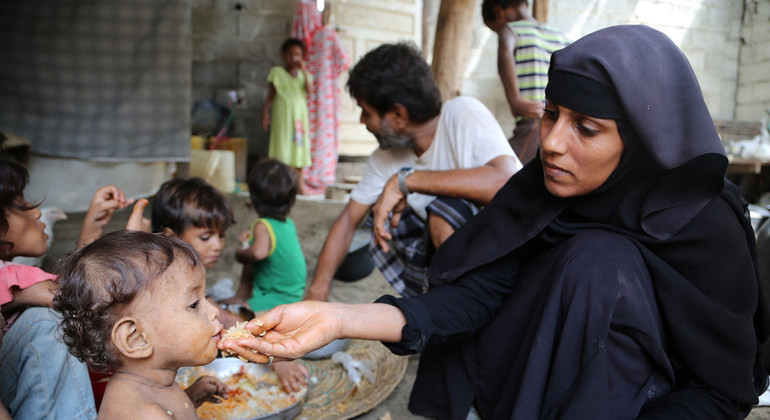
SANAA, Nov. 16 (Saba) -Since 2015, the war in Yemen has devastated civil infrastructure, displaced millions of people, and prompted an economic crisis, causing widespread severe acute food insecurity.
Five years of brutal war have left children and families in urgent need of food and water.
The country’s economy has been shattered. Countless homes, warehouses, farms and vital parts of civilian infrastructure have been destroyed. Basic services, like health or water supply, are collapsing.
Due to ongoing conflict and the resultant economic crisis, Yemen faces the largest food security emergency in the world.
Countrywide, approximately 17 million people—representing 56 percent of Yemen’s population—are experiencing Crisis (IPC 3) or worse levels of acute food insecurity and will likely continue to face Crisis or worse outcomes through at least early 2020,
Persistent conflict, rising food prices, reduced labor opportunities, depleted productive assets, and plummeting wages drive food insecurity in Yemen, with many Yemeni households relying on emergency food assistance to meet their basic needs.
In 2019, scaled-up food assistance in districts with households facing Catastrophe (IPC 5) conditions improved food security for some families. However, widespread needs remain unmet, and sustained humanitarian assistance is required to prevent worse outcomes.
Each voucher helps a family buy enough food for 1 month. Typically, the food available includes wheat, vegetable oil, sugar, pulses and iodized salt.
The boys and girls of Yemen are growing up in world’s largest humanitarian crisis, now in its fifth year. The need to stop the war on children has never been as urgent as it is at this moment. Nearly 14 million people are at risk of famine.
Parents are witnessing their children waste away, while vehicles transporting food are targets of attack. 2 million children are out of school and are at risk of exploitation and abuse.
The children of Yemen have been robbed of their basic rights to life, health and education.
Nearly 65 percent of people facing catastrophic food gaps live in four governorates: Hajjah, Hodeidah , Sa’ada and Taiz. These areas have experienced the most intense fighting – including air strikes, ground clashes and shelling .
Millions on Yemenis struggle each day to find enough clean water for cooking and washing.
Yemen has also been hit by the world's worst cholera outbreak. Cholera is transmitted through contaminated water or food and thrives in areas that lack proper sanitation facilities. It has affected 1.3 million people and caused the death of 2,800 people. 17.8 million people lack access to safe water and sanitation and are at risk of contracting cholera.
The huge rise in cholera, malaria and acute diarrhea in Yemen has compounded the country's malnutrition crisis. Yemen's health system is also nearing breaking point, suffering from acute shortages of fuel and medical supplies, which has left the country struggling to respond.
WFP provides monthly food rations to communities where the local market has largely collapsed due to the conflict.
Where the local markets are still functioning, WFP provides families with commodity vouchers or even cash to buy the same amount of food as provided in the monthly rations.
In addition to helping families meet their daily food needs, the vouchers and cash provide an essential boost to the local economy, which is essential to set Yemen on the road to recovery.
Written by Mona Zaid